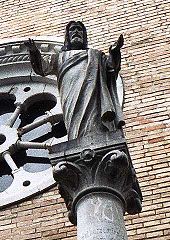Christ Church Opatija
The Evangelical Christ Church in the seaside resort of Opatija in Croatia was built in 1903 and 1904. It is a little off the Maršala Tita street, which runs parallel to the waterfront. From the small hill on which it stands, you can see the Kvarner Bay .
Architectural style
The church is built in neo-Romanesque style . Together with the parsonage built in Istrian style from 1911, it forms an urban ensemble with its Romanesque shapes and the open church pillar.
Beginnings of the church
Protestant life in Opatija goes back to the year 1895. At that time, the hall of the railway hotel Stephanie of the Austrian Southern Railway Company, today's Hotel Imperial, served as a place of worship . The services were held by the Berlin pastor Emil Frommel . The number of resident evangelical believers was initially only around 12, but in the main season over 100 believers attended the service. For the evangelical congregation it was therefore an urgent concern to find a suitable building site for their own place of worship.
Building the church
In 1902 the International Sleeping Car Company and the Austrian Southern Railway Company donated a piece of land. Many aristocrats as well as several Gustav Adolf associations from Germany and Austria supported the building with donations. The foundation stone was laid in May 1903 in the presence of the Grand Duke of Luxembourg . The architect was the Viennese professor Carl Seidl , who also designed numerous villas and hotels on the Kvarner Bay.
After almost a year of construction, the Christ Church was inaugurated on April 23, 1904. The guests included many aristocrats, including Grand Duke Adolf of Luxembourg and his wife Adelheid, King Oskar II of Sweden and Norway and his wife Sophia of Nassau , Emperor Franz Joseph of Austria and numerous clergymen.
Equipment of the church
The interior of the Christ Church, which is dominated by wood, reveals, among other things, an elaborately crafted coffered ceiling. Pulpit, baptismal font and the altar are also made entirely of wood. The colorful altar window shows Jesus Christ. Angels making music are depicted on two other stained glass windows . The harmonium made by the Kotykiewicz company in Vienna on the gallery is well worth seeing , a gift from Queen Elisabeth of Romania ( Elisabeth zu Wied ) in 1896. The two bells from 1904 and 1929 are also donated. The statue of Christ standing on a high column in front of the church is made entirely of Istrian stone.
Parish in the 20th century
In 1907 the community already had 100 members. In 1908 the preaching station was raised to the Protestant parish of the Augsburg and Helvetic Confessions in the area of the Trieste Seniorate . In 1919, after the First World War and the collapse of the Austro-Hungarian Empire, all of Istria became part of Italy. In 1920 the Protestant congregation in Opatija signed a contract with the Tavola Valdese, the Italian Waldensian church , with which it took over all the rights and obligations of the congregation and thus employed all clergy from now on.
When Istria was awarded to Yugoslavia after the end of the Second World War, the pastor Edgar Popp took over responsibility until 1960. Thereafter the community was administered by Vlado Deutsch until his death in 1999. Church services have not been held regularly since then, even during the season.
literature
- Herbert Patzelt: Evangelical life on the Gulf of Trieste: History of the evangelical community in Trieste with Abbazia, Görz, Fiume and Pola . Evangelical Press Association for Bavaria, Munich 1999, ISBN 358330022X .
Web links
Coordinates: 45 ° 19 ′ 30 ″ N , 14 ° 17 ′ 55.7 ″ E


